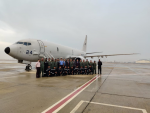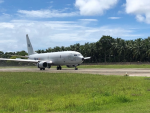Delighted With Fleet, Indian Navy Clears Decks For 6 More P-8Is
By Shiv Aroor Nov 28 2019, 7:17 pm
View attachment 11654
Given how deeply satisfied the Indian Navy has been with the fleet, it was only a matter of time. The Indian Navy’s case for more of these aircraft has been too strong to delay further. And that’s why the Indian MoD today cleared decks for the Indian Navy to acquire six additional
Boeing P-8I long range maritime surveillance and anti-submarine aircraft. With eight already in service, and
four ordered in 2016, the fresh imminent acquisition will give the Indian Navy a fleet of 18 aircraft. The four additional aircraft already on order
will be delivered in 2020-21.
The
Harpoon-armed P-8I has ably plugged into the Indian Navy’s vast responsibilities in the region, finding itself deployed across missions, from tracking Chinese submarines in the Indian Ocean to assisting in the hunt for the missing MH370 airliner,
disaster response, and crucially, the
search for lost military aircraft in India’s notoriously difficult north-east. A pair of these aircraft were particularly helpful in keeping tabs on Chinese movements during the Doklam military standoff between India and China in 2017, and
kept an eye on the Indian Air Force’s vintage Dakota DC-3 when it was flown in last year. The
tracking of Chinese nuclear submarines in the southern Indian Ocean (we’ll have a more detailed report on this shortly) is one of the chief reasons why the Indian Navy has insisted on a larger fleet of P-8Is. The aircraft are said to have performed well in tracking missions in 2017-18.
Indian P-8Is have also been fielded regularly at exercises. One recently flew to Qatar for the Roar Of The Seas exercise, the first naval exercise between the two countries :
View attachment 11655
P-8I in Qatar this month for ‘Roar Of The Seas’ exercise
As things stand, the Indian Navy will be looking to expand P-8I operations beyond the fleet’s current home base in Arakkonam in Tamil Nadu.
“The next step is to develop maintenance facilities for the fleet in the Andaman Islands and Goa to give the Indian Navy flexibility in deploying these aircraft where they are needed the most,” says Capt. Dalip Kumar Sharma (Retd.), former spokesperson for the Indian Navy, and who helmed the service’s public affairs during much of the P-8Is entry into Indian service. He indicates the staggered deliveries of the P-8I were requested by the Indian Navy to allow for additional support infrastructure for the P-8I at air stations beyond Arakkonam.
View attachment 11656
Primary and secondary maintenance facilities will come up at the Port Blair air station followed by a limited support infrastructure at the INS Hansa naval air station in Goa, where the Indian Navy operates its Il-38SD maritime surveillance aircraft fleet. The P-8Is augmented and then replaced the Indian Navy’s old Soviet Tu-142s, which were retired last year. It is understood that P-8I infrastructure at Goa will be more than just a ‘stage-through’, with a limited maintenance facility likely.
View attachment 11657
P-8I on maiden visit to Car Nicobar in Oct 2018
Boeing began delivering P-8Is to the Indian Navy in May 2013. The aircraft deal was signed long before India and the United States had signed COMCASA, an India-specific version of the Communications Interoperability & Security Memorandum of Agreement (CISMOA) that facilitated the export of advanced/sensitive technologies. As a result, the Indian Navy P-8I
came without certain kit standard on the US Navy version. These were made up for with Indian-developed systems sourced from Indian defence firms, an excellent early example of the Indian private sector meeting specific high technology needs in the defence space, and something that would clear the way for much current work :
View attachment 11658
Like the US Navy version, the Indian Navy’s P-8I sports the Raytheon AN/APY-10 as its primary maritime radar. The Indian version, however, also comes fitted with an aft radar, the Telephonics APS-143 OceanEye and the CAE AN/ASQ 508A magnetic anomaly detector (MAD).
Livefist learns that the Indian Navy is weighing a performance-linked logistics & sustainment plan with Boeing for P-8I fleet on the lines of what the Indian Air Force has with its fleet of 11 C-17 Globemasters.
It isn’t clear of the Indian Navy will look for more than 18 P-8Is. The navy contemplated a medium range maritime surveillance (MRMR) capability, and even floated a contest inviting bids for more modest aircraft for tactical/coastal reconnaissance. The erstwhile contest saw Boeing field a P-8I ‘Lite’, stripped of certain advanced sensors and technology. Things have changed since, with the Indian Navy placing such missions mostly on its Dornier Do-228 fleet, with a door tentatively open for the
proposed C295 based multi-mission maritime aircraft being developed by India’s DRDO.
https://www.livefistdefence.com/201...ndian-navy-clears-decks-for-6-more-p-8is.html




















